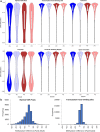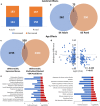Age-dependent VDR peak DNA methylation as a mechanism for latitude-dependent multiple sclerosis risk
- PMID: 33541415
- PMCID: PMC7863270
- DOI: 10.1186/s13072-021-00383-x
Age-dependent VDR peak DNA methylation as a mechanism for latitude-dependent multiple sclerosis risk
Abstract
Background: The mechanisms linking UV radiation and vitamin D exposure to the risk of acquiring the latitude and critical period-dependent autoimmune disease, multiple sclerosis, is unclear. We examined the effect of vitamin D on DNA methylation and DNA methylation at vitamin D receptor binding sites in adult and paediatric myeloid cells. This was accomplished through differentiating CD34+ haematopoietic progenitors into CD14+ mononuclear phagocytes, in the presence and absence of calcitriol.
Results: Few DNA methylation changes occurred in cells treated with calcitriol. However, several VDR-binding sites demonstrated increased DNA methylation in cells of adult origin when compared to cells of paediatric origin. This phenomenon was not observed at other transcription factor binding sites. Genes associated with these sites were enriched for intracellular signalling and cell activation pathways involved in myeloid cell differentiation and adaptive immune system regulation.
Conclusion: These results suggest vitamin D exposure at critical periods during development may contribute to latitude-related differences in autoimmune disease incidence.
Keywords: Calcitriol; DNA methylation; Epigenetics; Myeloid; VDR binding site; Vitamin D.
Conflict of interest statement
The authors declare that they have no known competing financial interests or personal relationships that could have appeared to influence the work reported in this paper.
Figures







References
Publication types
MeSH terms
Substances
LinkOut - more resources
Full Text Sources
Other Literature Sources
Medical
Research Materials

